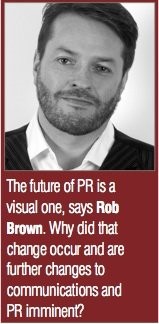
HUMAN COMMUNICATION IS EVOLVING
“We are moving incrementally away from text-based communication to more visual exchanges"
 What does the future look like for the PR industry? Change by its very nature is unpredictable, although there is one certainty; change doesn’t stop. Now that social and online channels are everyday elements in the life of PR practitioners, can we pause for breath, until the next challenge appears on the horizon? I don’t think we can.
What does the future look like for the PR industry? Change by its very nature is unpredictable, although there is one certainty; change doesn’t stop. Now that social and online channels are everyday elements in the life of PR practitioners, can we pause for breath, until the next challenge appears on the horizon? I don’t think we can.
At the heart of PR lies language and language is changing. I don’t just mean the natural evolution of language, the changes that enrage the curmudgeon many of us have lurking within. These natural changes include the use of exit as a verb, phenomena and criteria used in the singular. When I see that sort of language in a press release, I can literally explode (geddit?). The truth however is that the future will accept these changes.
I am referring to something much larger and more fundamental than the evolution of language. We are moving incrementally away from text-based communication to more visual exchanges. Emojis may be a fad but they represent the visualisation of feelings, emotions and responses. They may appear to many as trivial, or even irritating but it is impossible to refute the fact that they are a visual form of communication supplanting text.
Pete Cashmore, the founder of Mashable, speaking at SXSW in Austin, Texas this year talked about the, “Former era of text based communication.” He did so on the same day Mashable announced a deal with Bravo to produce four short-form video series for the NBCUniversal-owned TV channel. Mashable now focuses on video rather than the text-based communication on which it was founded.
The consumption of video is breathtaking. YouTube has in excess of four billion video views a day. Facebook claims more than double that, although it measures a view at three seconds against the 30 seconds it takes for a YouTube view to count. Facebook views doubled in eight months during 2015. Newspapers are increasingly desperate for video content. Despite the refusal of print to die, newspaper brands are primarily focused on their online properties. Their editorial decisions are driven by online statistics, views, eyeballs. The analytics are irrefutable, video drives views. For that reason, newspapers want video. People want to see and hear stuff rather than read it. When you stand back from the technology aspect, the trend is obvious. There used to be a hierarchy in the value PR people gave to media coverage; print as the bedrock, then radio and and at the apex, broadcast TV. We understand video, we know why people consume it. Though in the past it just wasn’t something that that we dealt with on a daily basis. Now that most people have the means to access TV (although it’s usually referred to as content) in their pockets, why wouldn’t they watch it multiple times per day and wherever they were?
The message for PR people is written in black and white, perhaps that should be in glorious Technicolor. Press releases and email remain valuable. Still images are not going away, but there is an inexorable rise in video content. It is a lexicon we must understand and adopt. It’s a daunting prospect but an exciting one. The cost of producing compelling video is falling dramatically. You can shoot in slow motion on an iPhone, there are apps that provide professional looking motion stabilisation. Simple editing programmes are universally available at low cost or even for free. Beyond that, we can engage specialist support. The little black book must now include videographers alongside photographers. With the ability to go straight to the consumer via owned media channels, PR has never had a more pivotal role in communications. Change doesn’t stop and video is the future, for the time being.
Rob Brown is president of the CIPR



